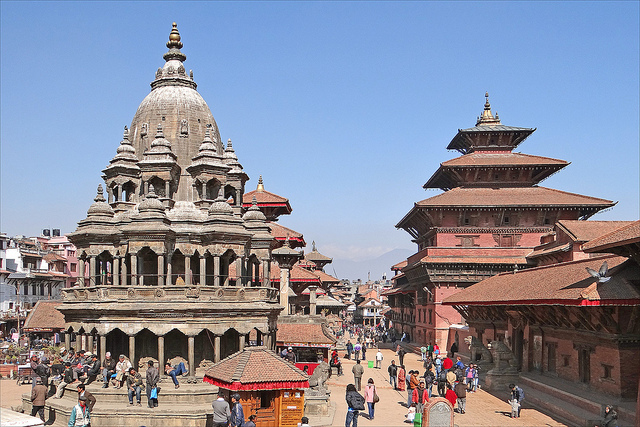Kathmandu Valley is a hub of overwhelming activity, surrounded by Himalayan peaks drizzled in icing-white snow, shimmering behind a city glaze of heat, dust and fumes. One of the valley’s three Royal Cities, Patan is a worthy base for appreciating traditional craftsmanship and absorbing Nepali culture.

Durbar Square. Patan (Jean-Pierre Dalbéra via Flickr)
A small crowd gathers in a narrow street, the stench of anticipation in the air. I can’t help but stop; the feeling is contagious. I don’t know what I’m waiting for, but the locals are smiling and laughing, eyes glued to a dwarfed wooden door embedded in the wall.
The door opens and a ribbon of linen-clad men appears, waistcoats and printed hats like paper boats. There’s a break, and then, struggling through the doorway, a new crowd bends through, carrying a tiny, wrinkled man on a pagoda strung with rainbow streamers. Soon after, a second cluster appears, this time carrying an equally tiny woman. She is the star of the show, but she looks down, as though she has seen it all before. It’s an anniversary celebration, and the whole town is out to watch. Soon enough, the crowd disperses, with the anniversary party melting into the busy main street, while I duck into quieter alleyway.
Temples & Trinkets
I’m in Patan, a city not far from Kathmandu and known for its gifted craftsmanship; at every turn there’s a poky boutique showered in things; silver jewellery set with semi-precious stones, shelf upon creaky shelf of carved wood and stone creatures, metal statues – many triple-limbed Hindu gods among them – heaped vats of powdered spices, incense and a kaleidoscope of patterned rugs.
Patan’s official name is ‘Lalitpur’, which translates as the City of Beauty. It’s one of the Kathmandu Valley’s three Royal cities, from the days when the Malla Kings ruled the lands in the medieval period. A city of artisans, Patan is home to some of the country’s most intricate and opulent temples. Some of Nepal’s largest festivals, though taking place throughout the country, are best witnessed here – from Bhadau, Krishna’s birthday and the three-day women’s festival in August to Dashain in September, which commemorates the victory of gods over wicked demons.
While there is a myriad of fascinating sights to visit, I prefer to wander than spend the day ticking off a checklist. I start off in the UNESCO World Heritage Durbar Square, a testament to Newari architecture, which sits at the quarter’s heart with a Buddhist monastery at its core and leads off to a maze of pagoda temples, Hindu and Buddhist shrines and ancient engraved palaces. It’s a hypnotic place to simply to get lost among winding alleyways, dead ends and communal squares behind sheltered doorways; to meander through the city’s veins makes me feel a part of it.
Taking a Step Back from the Crowd
Out on the main strip, I can’t fathom the thought of fighting through the market. The streets are filled with rickety cars, prayer beads swinging from their rear view mirrors, open trucks and ancient motorbikes. Children scatter in the smoky wake, while sacred cows are given a wide berth as they rest wherever they please, causing endless traffic jams. A man with one arm and one leg slithers along the road, dodging a silver tin bus and hauling himself up a telegraph pole.
I grow increasingly agitated, turning corners just to avoid the shouting taxi drivers and dodging up precarious warped pavements as tuk-tuks hurtle past until I slip down a dark passage and find a quiet courtyard with an elaborate terracotta Buddha fountain. I sit on the lip of the fountain and catch my breath. High above, women shake out sheets and hang them on drooping lines like a string of coloured flags.
I wander further out into the suburbs and cross a bridge, one of many that slopes over a river filled to the brim with steaming rubbish. It’s a reminder, if any was needed, that Nepal still has a long way to go in terms of development. Suddenly I yearn for the distraction of the main street again. Up ahead, a woman carries a twinkly-eyed infant in swathes of textured fabrics. I smile involuntarily and the woman smiles back for just a moment, a smile that reaches beyond the corners of her lips and fills her copper eyes.
She turns and her baby continues to stare over her shoulder as she picks her way across the street. For a city that has had its fair share of invasion – from tourists, hikers, gem-hunters and dreadlocked expats, there’s still a smile at every turn.
What to see
A plethora of temples makes it difficult to decide on what’s worth a look. Kumbheshwar is one of just three surviving five-storey temples in Nepal with a natural spring in the courtyard, the source of which is said to be glacial lake Gosainkunda.
Stop at Arjun Art Gallery for authentic Himalayan watercolours, sketches and oil paintings, while Om Handicrafts sells traditional Healing Bowls and knickknacks.
While it may sound unappealing, nearby Patan Industrial Estate is the one of the best places to shop for gifts, with factory showrooms selling wood and metal work and hand-woven carpets. Also on the outskirts of the city, there’s a Tibetan Refugee camp with stalls selling trinkets, among them handmade jewellery, wool carpets and prayer wheels.